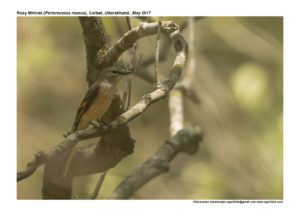
Rosy Minivet Pericrocotus roseus
Etymology:
- Pericrocotus : Greek word for perivery, all around; krokotos-golden-yellow derived from krokos- saffron
- Roseus : Latin word for Rose coloured derived from rosa –
Vernacular Names: Cachar: Dao ribi, Hindi: Gulabibulalchashm
Distribution in India: Resident of Himalayas and North East India.
Description: Size of 19-20 cm.The Male has whitish forehead, supraloral stripe and eyelids, black lores, pale grey face to ear-coverts; crown to upper back and scapulars brownish-grey to grey, lower back to uppertail-coverts tending to pale rosy, uppertail-coverts tipped vermilion; wings greyish-black, greater upperwing-coverts tipped vermilion, merging into bright vermilion basal bands on remiges, these running obliquely across wing , distal outer webs of tertials and inner secondaries vermilion; central pair of rectrices black-brown, second pair vermilion on outer web, remainder largely vermilion; chin and throat white, washed pink, underparts pink. Female is similar in pattern to male, but upperparts olive-tinged grey, back to uppertail-coverts often paler olive-yellow with yellower feather tips, secondary coverts tipped and edged yellow; wing flash also yellow, tail predominantly yellow; underparts dull yellow.The juvenile resembles female, but more brownish, with pale yellowish feather tips on head and upperparts, obscure dark scaling or mottling on breast. The immature is like female.
Habitat: It is found in different types of forest, including broadleaf evergreen, deciduous and pine also woodland, wooded valleys and gardens; sometimes occurs in towns.
Food Habits: It eats Insects and other small arthropods. Commonly recorded in pairs, but often occurs in flocks in non-breeding season. Forages in canopy and sub-canopy foliage; less active than other minivets.
Breeding Habits: They breed in April-June in India.The nest is built mainly by female, accompanied by male, a small, neat, deep cup of roots, twigs, grass stems, lichens and cobwebs, attached to horizontal tree branch. They lay a clutch of 2-4 eggs. The incubation period is 11 days and fledging period is 12 days. The young are fed by both sexes.